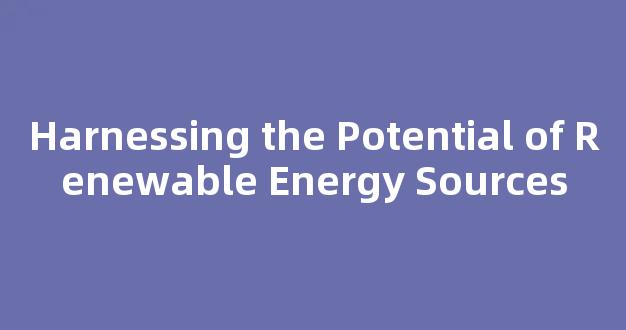Harnessing the Potential of Renewable Energy Sources
Renewable energy sources have been gaining popularity in recent times. With the increasing concerns over climate change and the need to reduce carbon emissions, renewable energy sources have become a viable alternative to traditional fossil fuels. This article will explore the different types of renewable energy sources, their potential, and how they can be harnessed to meet the growing demand for energy.

The Types of Renewable Energy Sources
Renewable energy sources can be broadly classified into five categories: solar, wind, hydropower, geothermal, and biomass. Solar energy is derived from the sun’s rays and can be converted into electricity through the use of solar panels. Wind energy is generated by the movement of air, which turns wind turbines to produce electricity. Hydropower is generated by the force of water flowing in rivers and streams, which is used to turn turbines and generate electricity. Geothermal energy is derived from the earth’s heat and can be used to produce electricity or for heating and cooling buildings. Biomass energy is derived from organic matter, such as plants and trees, and can be used to produce electricity or as a source of fuel.
The Potential of Renewable Energy Sources
Renewable energy sources have immense potential to meet the world’s energy needs. According to the International Energy Agency (IEA), renewable energy sources could provide up to 80% of the world’s electricity by 2050. Solar energy alone has the potential to meet the world’s energy needs several times over. Wind energy is also a significant contributor, with large wind farms capable of generating electricity for entire cities. Hydropower is currently the largest source of renewable energy, accounting for around 16% of global electricity generation. Geothermal energy has huge potential in areas with high geothermal activity, such as Iceland and Indonesia. Biomass energy can also play a significant role in meeting the world’s energy needs, particularly in rural areas where access to electricity is limited.
How Renewable Energy Sources Can Be Harnessed
Renewable energy sources can be harnessed through a variety of methods. Solar energy can be converted into electricity through the use of photovoltaic cells or concentrated solar power systems. Wind energy can be harnessed through the use of wind turbines, which convert the kinetic energy of the wind into electricity. Hydropower can be generated through the construction of dams and the installation of turbines. Geothermal energy can be harnessed through the use of geothermal power plants. Biomass energy can be used to produce electricity through the use of biomass power plants or used as a source of fuel for heating and cooking.
Conclusion
The world’s growing energy needs can be met through the use of renewable energy sources. Solar, wind, hydropower, geothermal, and biomass energy have immense potential to meet the world’s energy needs sustainably. Governments and businesses need to invest in developing and harnessing these renewable energy sources to reduce our dependence on fossil fuels and mitigate the impact of climate change.